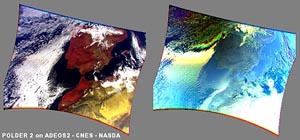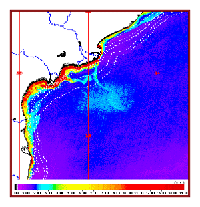

|
|
The IOCCG Committee met for the 8th time in Florence, Italy (February 24-26, 2003). Participants were welcomed in the magnificent Tribuna di Galileo, a historic gallery with a statue of Galileo and decorated with a series of frescoes depicting some of the fundamental moments in the history of physics. Committee members reviewed the progress of the various IOCCG working groups. To date there are six active working groups, two of which are nearing completion and are expected to publish their findings in the form of an IOCCG report. These include the Working Group on Data-Binning Issues (Chair Dr. David Antoine) and the Working Group on Comparison of Atmospheric Correction Algorithms (Chair Dr. Menghua Wang). In addition, two proposals were received to establish new IOCCG working groups: the Ocean-Colour Algorithm Working Group (Chair: Dr. ZhongPing Lee) and the Working Group on Biogeographical Methods (Chair: Dr. Mark Dowell). Details of these working groups will be available on the IOCCG website shortly. Participants were also briefed on the status of the current and future ocean-colour sensors. The Committee also addressed capacity building initiatives and agreed to sponsor or coordinate a number of new activities, including a South Pacific Training course (to be held in Brisbane), and the Southern Hemisphere Cruise (see announcement below). Preliminary plans for a NASDA-sponsored training course to be held in Indonesia, were also presented to the Committee. A full report on the 8th IOCCG Committee meeting will be available in due course on the IOCCG website.
The IOCCG Committee established a new category of membership i.e. Associate Membership (see Terms of Reference). This would be conferred upon persons outside the Committee who have made, or continue to make, a significant contribution to the activities of the IOCCG, as a form of recognition of their involvement. Prof. André Morel was nominated as the first Associate Member of the IOCCG. He has made an outstanding contribution to the activities of the IOCCG since its inception in 1996. He was the Chair of IOCCG's first scientific working group, producing the comprehensive report on "Minimum Requirements for an Operational Ocean Colour Sensor for the Open Ocean" (IOCCG Report Number 1, 1997). He also chaired the working group on "Standardising the Extraterrestrial Solar Flux Spectrum". Prof. Morel has served two full terms (3 years each) on the IOCCG Committee and has provided expert advice in many different areas. As an Associate Member he will continue his involvement with the affairs of the Committee. It is fitting that one who has played such an important role in bringing the IOCCG to the level of recognition that it enjoys today should be the first to be appointed in this new category!

The Japan Marine Science and Technology Center (JAMSTEC) is organising an international circumpolar cruise in the Southern Hemisphere on board the Research Vessel Mirai. The project, termed BEAGLE 2003 (Blue EArth GLobal Experiment), will be comprised of six-legs, each approximately four weeks long, starting in Brisbane, Australia on 3 August, 2003 and ending in Fremantle, Australia on 19 February, 2004. The International Ocean-Colour Co-ordinating Group (IOCCG) and the Partnership for Observation of the Global Oceans (POGO) are offering a limited number of Scholarships for young scientists to participate in any one leg of the cruise. Participants will receive hands-on training in bio-optical and other measurements on board a research vessel. For further details about these scholarships, please see the announcement on the IOCCG Training and Education web page.
The MODIS Ocean Products Workshop was held February 3 - 4, 2003, at the University of New Hampshire's New England Center in Durham, New Hampshire. This workshop was a comprehensive summary of the status of the 48 data products derived from MODIS ocean color and infrared measurements. Further details can be found on the the workshop web page.
MODIS Terra Ocean-Colour Data are of validated maturity. Collection 4 reprocessing is now complete and covers the period February 24, 2000, to June 1, 2002. The forward processing beginning June 2, 2002, is also part of Collection 4 and uses the same algorithms as the reprocessing, but with extrapolated calibrations for the visible bands. The status of Collection 4 data (for ocean colour) is as follows:
Terra Reprocessing Update: The period September 2001 - December 2002 will be reprocessed starting in late May 2003. This will decrease time trends (resulting from sensor behaviour shifts not accounted for in the calibration) and reduce discontinuities (resulting from different code versions in the processing stream) seen the current Collection 4 data. The newly reprocessed data will be archived as Collection 4 and will replace the existing Collection 4 data in the archive.  MODIS Aqua Ocean-Colour data is with provisional maturity. Ocean-colour products level 2 and 3 are considered provisional products for collection 3 for the period beginning 29 November, 2002. Ocean-Colour products produced prior to 29 November 2002 are considered beta and will not be publicly available until reprocessed. Further details can be found on the MODIS Ocean Website.
The SeaWiFS mission has been working extremely well for over 5 years and the instrument is still very stable. Unfortunately the NASA contract with ORBIMAGE to receive SeaWiFS data expires in December, 2003. NASA Headquarters have agreed to one final reprocessing of the entire SeaWiFS data set after the last data are received in December, 2003. The reprocessing should be completed by March, 2004. |
NASDA successfully launched the ADEOS-II satellite (Advanced Earth Observing Satellite II) on December 14, 2002. The satellite is carrying two ocean-colour instruments: CNES's POLDER 2 imaging polarimeter and the Japanese GLI (Global Imager). In-orbit checkout operations conducted by CNES and NASDA are proceeding according to plan and will continue until April 2003, when the system will enter operational service. Both instruments are working according to specifications. The first light image from GLI was obtained on 25 January, 2003 and that of POLDER was acquired on 1 February, 2003. 
These two images were acquired on 1 February 2003 by POLDER-2 over the Iberian Peninsula and North Africa in natural light (left) and polarized light (right). Each image is a colour composite of three spectral bands-at 443 nm (blue), 670 nm (green) and 865 nm (red). Click on image for original announcement. Level 1 data from POLDER-2 will be distributed starting in September 2003 once CNES teams have validated image quality. CNES will use ground-based and in-situ measurements, as well as comparative data from other space-based sensors and various climatic and meteorological models to validate products. Validation is expected to be completed next year. Geophysical products will then be made available to the international scientific user community. POLDER-2 data will be used to study the interactions between clouds, aerosols and the Earth's radiation balance, and to gain a closer understanding of the role of marine phytoplankton and the continental biosphere in the carbon cycle.
The 8 months of POLDER 1 data were reprocessed in 2002 using the SeaWiFS OC2-v4 algorithm. 10-day and monthly syntheses of diffuse marine reflectance at 565 nm and chlorophyll concentration images and HDF binary data is available for download on the POLDER website.
The Indian Ocean-Colour Monitor (OCM) was launched in May 1999. It has a high spatial resolution of 360 m, with ground stations in India, USA, Germany and North Korea. Standard OCM data products consist of Level 1 (geometrically and radiometrically corrected radiances), Level 2 (chl, sediments, yellow substances, diffuse attenuation coefficient, aerosol optical depth and nLw) and Level 3 products (weekly and monthly averages generated on a trail basis). Level 1 and 2 data can be acquired by users directly from NRSA (at a nominal cost). Atmospheric correction procedures developed at SAC were compared with those of SeaDAS, and no major differences were found. One of major applications of OCM data is forecasting potential fishing zones. The forecasts help in reducing catch per unit effort, yielding catch increases of 70-200%. Other applications include detecting Trichodesmium blooms and understanding sediment transport. For more information regarding these applications, please contact: Dr. Shailesh Nayak  Coastal circulation and plume dynamics on 1 March, 2000 in the Krishna-Godavari Delta, Bay of Bengal, using OCM sediment data (TSM in mg/l).
On the 1st of March, 2003 the Envisat satellite, carrying the MERIS ocean-colour sensor, celebrated its first year in space. Based on the results of the calibration/validation reviews of Envisat, the commissioning phase of the mission was closed at the end of 2002, and ESA formally authorised the transition of Envisat into the initial operations phase. The Envisat Validation Workshop was held at ESA’s ESRIN facility in Frascati, Italy from 9-13 December, 2003. Over 400 scientists and engineers attended the meeting including 200 PI’s from the European science community who are working with ESA to calibrate the Envisat instruments and validate the data. In-flight spectral characterisation results of the MERIS instrument showed unprecedented accuracy, with the instrument performing better than specifications. The validation of MERIS data has started and the first results look very promising, but more match-up data are required to make a complete synthesis. MERIS Image Data can be viewed through the Envisat homepage and through the Multimedia Gallery on ESA’s homepage. Scientists are encouraged to apply for MERIS data through the rolling Announcement of Opportunity via the ESA website.
Effective February 2003, data from the Taiwanese OCI Sensor will be processed by the National Space Program Office (NSPO) of Taiwan, which is the funding agency of OCI SDDC (Science Data Distribution Centre). Data from 1999 to 2002 can be browsed on the OCI SDDC website.
The Partnership for Observation of the Global Oceans (POGO) and its partners, the Intergovernmental Oceanographic Commission (IOC) and the Scientific Committee on Oceanic Research (SCOR), are now inviting applications for their Visiting Fellowship program. The details regarding the fellowship and how to apply are available on the POGO website.
Several new workshops have been added to the Workshops & Conferences page of the IOCCG website.
Several new references have been added to the Bibliography and References pages of the IOCCG website. If you would like to see your references added to the IOCCG bibliography, please submit them to the IOCCG Information Officer. |
|
Material for possible inclusion in the IOCCG Newsletter should be submitted to the Project Scientist. If you would like to be placed on the IOCCG News mailing list, and receive a brief summary of the latest news by e-mail (approximately once every 2 months), please send an e-mail with 'subscribe' in the subject line to subscribe@ioccg.org.To unsubscribe from the IOCCG News mailing list please send a message with 'unsubscribe' in the subject line to unsubscribe@ioccg.org.
|
|
|
|